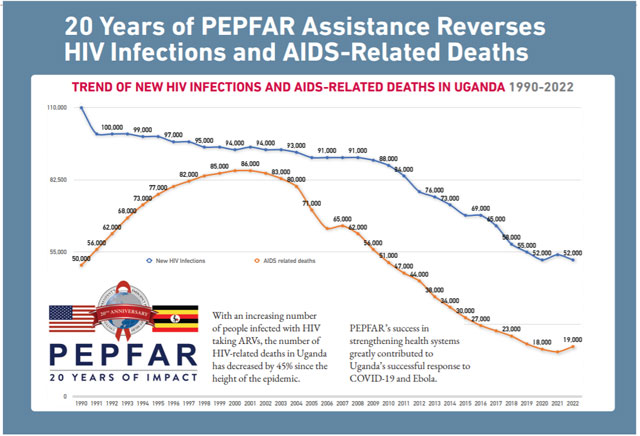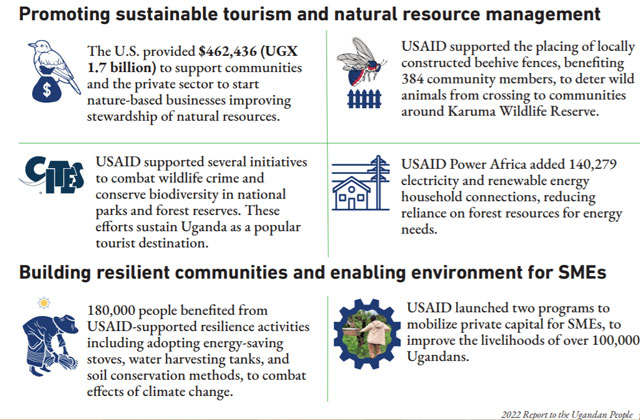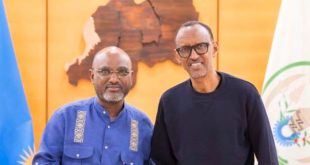
U.S. Mission Releases ‘Report to the Ugandan People’ 60th Anniversary Edition
Kampala, Uganda | THE INDEPENDENT | The U.S. Mission on Wednesday marked 60 years of USA-Uganda development partnership by releasing a 60th anniversary edition of the ‘Report to the Ugandan People’. This is the 6th consecutive annual report that chronicles the United States’ long partnership with Uganda’s people.
The Report to the Ugandan People launched by U.S. Ambassador Natalie E. Brown, highlights much of what the U.S. government does in Uganda, why they do it, and how they do it. This special edition features some of the millions of Ugandans whose lives have benefited from U.S.-funded programs in Uganda in the past six decades.
To date, more than 4,700 Ugandans have participated in U.S. government-supported exchange programs. Some of them, like Joyce Mpanga, who was a Fulbright Scholar, studied in Indiana and later became Uganda’s first Minister of Women in Development.
Through the 13 U.S. government agencies that comprise the U.S. Mission in Uganda, the United States invests almost USD 1 billion (UGX 3.6 trillion) annually in Ugandan communities, largely through more than 100 implementing partners and civil society organizations, many based in Uganda and Ugandan-led, that deliver programs to every district across the country.
“For much of Uganda’s 60 years of independence, the United States has been the country’s largest assistance partner. That remains the case today. In 2021, we provided assistance valued at $930 million dollars, or more than 3.4 trillion Ugandan schillings, for the Ugandan people and Ugandan communities,” said U.S. Ambassador Natalie E. Brown.

She said that in 2022, the US provided assistance at similar levels, but exact funding figures are not yet complete.
“While these figures are significant, the story of America’s partnership with the Ugandan people is not one of dollar figures, but of lives impacted. You may not always see our flag on large buildings or billboards, but thanks to the United States’ investment, millions of Ugandans are living healthy, learning better, earning more, and participating more fully in their communities,” Ambassador Brown said, citing the 1.3 million HIV+ Ugandans receiving U.S.-funded ARV treatment, the United States donating more than 18 million COVID-19 vaccine doses – free of cost, and the more than 4,700 Ugandan professionals who have participated in U.S. government-supported exchange programs.
Ambassador Brown was joined for the report launch by four senior members of the U.S. Mission Uganda team: Richard Nelson, Mission Director in Uganda for the U.S. Agency for International Development; Dr. Lisa Nelson, Director of the U.S. Centers for Disease Control and Prevention country office in Uganda; Mary Borgman, PEPFAR Country Coordinator, and Ellen Masi, the Embassy’s Public Affairs Counselor.
The officials gave health as one of the sectors that US assistance in Uganda has had a huge impact.
“Today, more than 1.3 million Ugandans living with HIV are receiving life changing ARV treatment through PEPFAR. With ARV treatment, they can pursue their education, start a family, build a career, prevent further infection, and expect to enjoy a long, healthy life,” said Ambassador Brown.
#USReport2UG: Read @USAmbUganda Natalie E. Brown's remarks on #Report2Uganda launch here: https://t.co/Hd7S21onnq
— U.S. Mission Uganda (@usmissionuganda) February 8, 2023
A research study shared at the PEPFAR Science Summit last week, shows that the tremendous scale up of PEPFAR-supported HIV treatment in Uganda since 2004 has averted almost 500,000 estimated HIV infections, including over 230,000 babies born infection free to HIV-positive mothers; and this investment prevented nearly 600,000 HIV-related deaths.
She added that more broadly, the United States’ programming in the health sector has transformed Uganda’s ability to respond to numerous infectious diseases and other health challenges, from COVID-19 to the Ebola virus.

Aside from the health sector, the US supports economic growth as it considers it key to improving livelihoods.
“That’s why the United States supports Ugandan businesses and entrepreneurs. With over 343 graduates of the Academy for Women Entrepreneurs – AWE – we are empowering women business owners to turn their creative ideas into jobs for the community. From Gulu and Mbarara to business owners in Jinja, Fort Portal, Mbale, and Kampala, we have seen over 280 of these women formally register their businesses, set up bank accounts, and join the formal economy,” ambassador Natalie said.
She said all US initiatives and programs align with Uganda’s Vision 2040 – Uganda’s development plan.
” Let me be clear – every dollar the United States invests in Uganda is held to the highest standards of oversight. Corruption is a significant challenge in Uganda and many countries throughout the world. And we are not immune to it in the United States. That’s why we have very rigorous processes in place for monitoring and evaluating how U.S. assistance funds are spent. We have even suspended programs due to underperformance. The United States strongly supports initiatives to promote financial transparency and accountability for the use of public resources, whether yours or ours.”


Ambassador Natalie told the press, that the United States believes the assistance they “provide Uganda today should not become a burden to the Ugandan people tomorrow”.
“That’s why the vast majority of United States assistance is direct to projects and not loans that must be paid back by future generations of Ugandans. The only re-payment we look for from beneficiaries of U.S. assistance is that they ‘pay it forward’ by applying the opportunities, knowledge, and tools gained through our programs to further the development of their communities and Uganda.”
The United States, she added, believes civil society organizations play a critical role in supporting service delivery in health, education, and other sectors; in promoting accountability; in advocating for effective laws and policies; and in advancing the rights of marginalized people. That’s why, she said, the vast majority of U.S. assistance in Uganda and elsewhere around the world is provided not to governments but implemented through partner organizations and civil society groups.
She concluded that, “In an era of misinformation and disinformation, where false claims about where U.S. assistance funding goes or how U.S. government funding is used, we want to be clear and transparent about U.S.-funded programs in Uganda. That’s why we’ve prepared this report. That’s why we’ve assembled U.S. Mission leadership team today to answer questions from the media. I should note, however, you do not have to wait for the Report to come out each year. The U.S. government’s ForeignAssistance.gov website provides this information to anyone who wishes to see.”
She reiterated that the United States believes that every country’s most valuable resource is its people.
“That’s why the overwhelming majority of U.S. assistance to Uganda is focused on building human capacity so Ugandans have the knowledge, skills, and resources they need to succeed not just today, but tomorrow: skills and resources that will benefit not just themselves, but their families, their communities, and their country for many years to come.”
*****
RELATED STORY
 The Independent Uganda: You get the Truth we Pay the Price
The Independent Uganda: You get the Truth we Pay the Price





What are they getting in return from this level of investment?
Uganda should not become a burden but in fact it is a burden. We get that and appreciate the support from the US but what can it do to over the the injustice within the country? and the corruption?